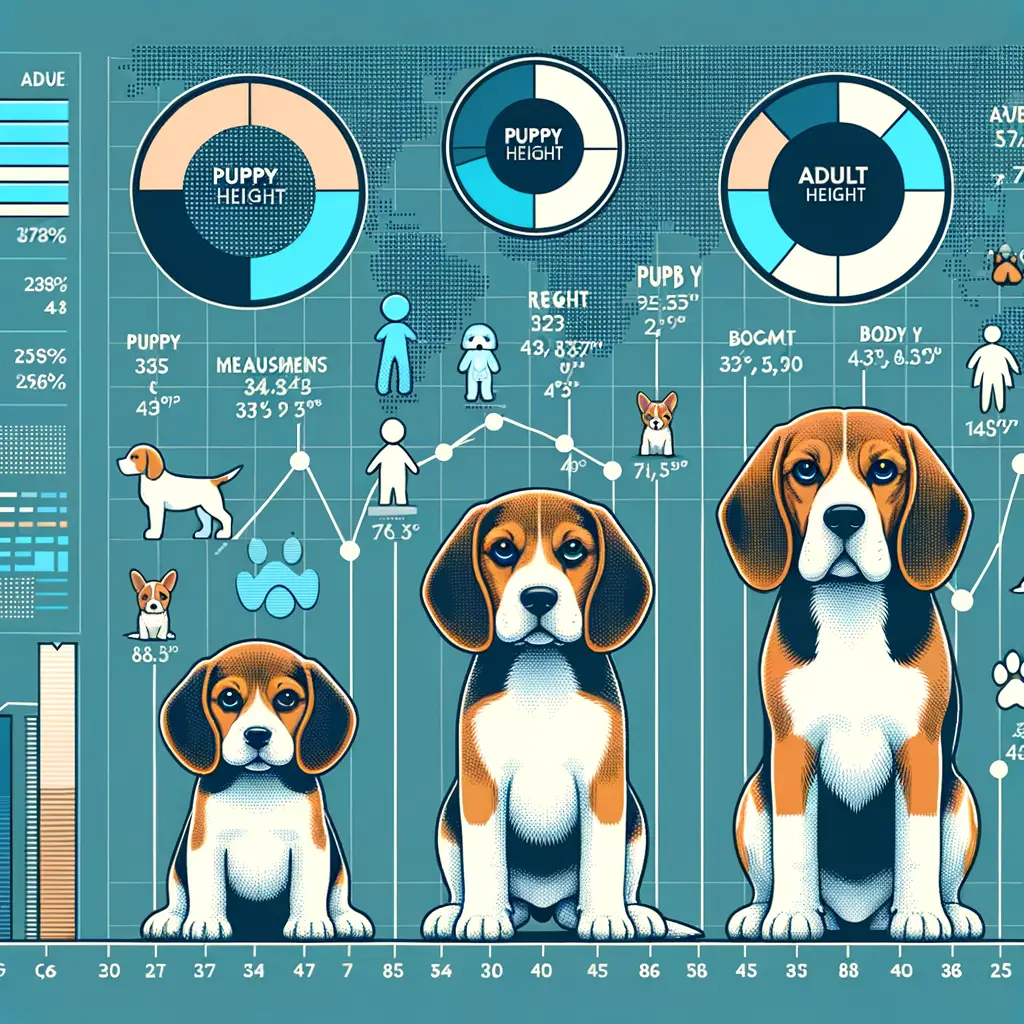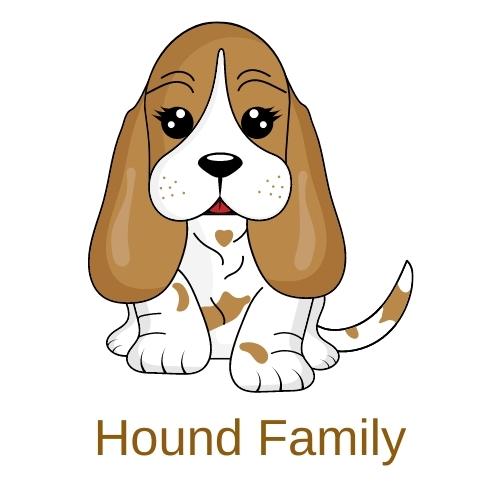
Introduction: The Beagle Size Mystery
Beagles are one of the most popular breeds of dogs, known for their friendly nature and distinctive appearance. However, there’s a certain mystery surrounding their size. This article aims to unravel this mystery and provide a comprehensive understanding of the Beagle breed’s size.
- Overview of the Beagle breed
Beagles are small to medium-sized dogs, originally bred for hunting. They are known for their keen sense of smell and tracking instincts, which make them excellent detection dogs. Beagles are intelligent, curious, and friendly, making them great companions for families and individuals alike.
Their coat is typically tri-colored or bi-colored with variations of white, tan, and black. The Beagle’s most distinctive features are its large, brown or hazel eyes and long, droopy ears. They have a sturdy, square build and are typically between 13 and 16 inches tall at the shoulder.
- Why understanding Beagle size is important
Understanding the size of your Beagle is crucial for several reasons. Firstly, it helps in providing the right amount of nutrition and exercise. Beagles are active dogs and require a diet that supports their energy levels. Knowing their size can help determine the right portion sizes and frequency of meals.
Secondly, understanding your Beagle’s size can help in training and managing them. Smaller Beagles might require different handling techniques compared to larger ones. Furthermore, knowing the size can also assist in choosing the right accessories such as collars, leashes, and beds.
Lastly, understanding your Beagle’s size can help you identify any potential health issues. Beagles are prone to certain health conditions like obesity, heart disease, and hip dysplasia, which can be influenced by their size. Regular monitoring of their size can help in early detection and prevention of these conditions.
In the following sections, we will delve deeper into understanding the Beagle size, including a detailed growth chart and physical characteristics. Stay tuned to embrace your Beagle’s size and ensure their overall well-being.
Understanding Beagle Size: The Basics
When it comes to understanding the size of a Beagle, there are a few basics that you need to know. Beagles are a medium-sized breed, but their height and weight can vary. Let’s dive into the specifics.
Beagle Height and Weight: The Facts
One of the first things you might want to know about Beagles is their average height and weight. These measurements can give you a good idea of what to expect as your Beagle grows.
- Average height of Beagle
- Typical Beagle weight
The average height of a Beagle can vary depending on whether it’s a male or female. Males typically stand between 14 and 16 inches tall at the shoulder, while females are slightly smaller, usually standing between 13 and 15 inches tall.
Beagles are known for their sturdy, muscular build. A healthy adult Beagle usually weighs between 20 and 30 pounds. However, their weight can vary depending on factors such as diet, exercise, and overall health.
Remember, these are just averages. Each Beagle is unique and may not fit perfectly into these ranges. It’s always best to consult with your vet if you have concerns about your Beagle’s size.
Beagle Dimensions: More Than Just Height
When we talk about the size of a Beagle, we often think about their height. But there’s more to a Beagle’s size than just how tall they stand. Let’s explore two other important dimensions of a Beagle: their length and chest circumference.
- Beagle Length
Beagles are known for their compact, muscular bodies. The length of a Beagle is measured from the base of the tail to the tip of the nose. On average, a fully grown Beagle can measure anywhere from 13 to 16 inches in length. This measurement can give you a good idea of how much space your Beagle might take up on your couch or bed!
- Beagle Chest Circumference
The chest circumference of a Beagle is another important dimension to consider. This measurement is taken around the widest part of the Beagle’s chest, just behind the front legs. It’s an important measurement to know, especially when buying a harness or a coat for your Beagle. On average, a Beagle’s chest circumference can range from 17 to 20 inches.
Understanding these dimensions can help you better accommodate your Beagle’s needs, whether it’s buying the right size accessories or understanding how much space they’ll need at home. Remember, every Beagle is unique and these measurements can vary based on factors like genetics, diet, and exercise.
| Beagle Dimension | Average Measurement |
|---|---|
| Length | 13 to 16 inches |
| Chest Circumference | 17 to 20 inches |
So, when you think about your Beagle’s size, remember to consider more than just their height. Their length and chest circumference are equally important dimensions that contribute to their overall size and stature.
Beagle Growth Chart: A Detailed Look
Understanding the growth of your Beagle puppy can be both exciting and challenging. Let’s dive into the details of the Beagle growth chart and understand what to expect during the early months.
Beagle Puppy Height: The Early Months
During the early months, your Beagle puppy will experience rapid growth. This is a crucial period in their development, and it’s important to monitor their progress closely.
- Height progression in the first 6 months
- Factors affecting puppy growth
During the first six months, a Beagle puppy will grow rapidly. At birth, they are typically around 5-6 inches tall. By the end of the first month, they could reach up to 9 inches. By six months, most Beagle puppies will be close to their adult height, which is typically between 13 and 15 inches. Remember, these are average figures and individual growth can vary.
Several factors can affect the growth of your Beagle puppy. These include genetics, diet, and exercise. A balanced diet rich in proteins and vitamins is essential for healthy growth. Regular exercise is also important as it helps to build strong muscles and bones. However, over-exercising can be harmful to a growing puppy, so it’s important to strike a balance.
Understanding your Beagle’s growth can help you provide the best care possible. Remember, every Beagle is unique and will grow at their own pace. Be patient, provide a healthy diet and plenty of love, and your Beagle will grow into a strong and healthy adult.
Adult Beagle Height: Full Growth
As your Beagle transitions from a playful puppy to a mature adult, you may wonder when they will reach their full height and weight. Let’s explore these questions in detail.
- When does a Beagle stop growing?
- How much does an adult Beagle weigh?
Beagles typically stop growing in height around the age of 18 months. However, they may continue to fill out, gaining muscle and fat, until they are about 2 years old. It’s important to remember that each Beagle is unique, and growth rates can vary based on factors such as diet, exercise, and genetics.
An adult Beagle typically weighs between 18 and 30 pounds, depending on their gender and overall health. Males generally weigh more than females. A healthy weight for your Beagle is crucial to their overall health and longevity. Overweight Beagles can face a range of health issues, including heart disease and joint problems.
Here’s a quick reference table to help you understand the typical height and weight of an adult Beagle:
| Age | Height | Weight |
|---|---|---|
| 18 months – 2 years | 13-15 inches | 18-30 pounds |
Remember, these are average figures. Your Beagle’s growth may differ slightly. Always consult with your vet if you have concerns about your Beagle’s growth or weight.
Beagle Stature: Physical Characteristics
Understanding the physical characteristics of your Beagle is a crucial part of pet ownership. In this section, we will delve into the specifics of Beagle measurements, providing you with a comprehensive guide on how to accurately measure your Beagle’s height and weight.
Beagle Measurements: A Comprehensive Guide
Measuring your Beagle’s height and weight is not as complicated as it might seem. Here’s a step-by-step guide to help you:
- How to measure a Beagle’s height
- How to measure a Beagle’s weight
The height of a Beagle is measured from the floor to the shoulder. To get an accurate measurement, make sure your Beagle is standing on a flat surface. Use a measuring tape and place it at the base of the paw, then measure up to the highest point of the shoulder. The average height of a fully grown Beagle is between 13 to 15 inches.
Measuring a Beagle’s weight is best done using a pet or home scale. If your Beagle is small enough, you can hold them while standing on the scale, note down your weight, and then weigh yourself alone. Subtract your weight from the combined weight to get your Beagle’s weight. A healthy adult Beagle typically weighs between 20 to 30 pounds.
Remember, these measurements are averages and individual Beagles may vary. Always consult with your vet if you have concerns about your Beagle’s size or weight.
Beagle Physical Characteristics: Beyond Size
While size is a significant factor in understanding a Beagle’s physical characteristics, it’s not the only one. Beagles have other distinctive features that make them unique and easily recognizable. Let’s delve into two of these features: their coat and color, and their ear size and shape.
- Beagle Coat and Color
Beagles have a dense double coat that is weather-resistant, designed to protect them from harsh weather conditions. This coat is short and requires minimal grooming, making Beagles a low-maintenance breed.
The color of a Beagle’s coat is another distinctive feature. Beagles typically come in a variety of colors and patterns. The most common colors are tri-color (black, white, and tan), but they can also be found in colors like red and white or lemon and white. Each Beagle’s coat is unique, adding to their charm and individuality.
- Beagle Ear Size and Shape
Beagles have long, wide ears that hang down past their cheeks. These ears are soft to the touch and have a rounded tip. The size and shape of a Beagle’s ears are not just for looks; they serve a purpose. When a Beagle lowers its head to sniff, the ears help to trap and hold scents closer to their nose, enhancing their exceptional sense of smell.
Understanding these physical characteristics beyond size can help you better appreciate the unique beauty of Beagles. Remember, while size may vary, these features remain constant and are part of what makes a Beagle, a Beagle.
Conclusion: Embracing Your Beagle’s Size
As we’ve journeyed through the world of Beagle sizes, we’ve learned many things. We’ve discovered that Beagles come in a variety of sizes, and that these sizes are determined by a combination of genetics, diet, and exercise. But most importantly, we’ve learned that the size of a Beagle does not define its personality or its health. Let’s delve deeper into these insights.
- Why size doesn’t define your Beagle’s personality
- How to ensure your Beagle is healthy, regardless of size
Beagles are known for their friendly and outgoing personalities. These traits are not determined by their size, but rather by their breed and individual temperament. A small Beagle can be just as energetic and playful as a larger one. In fact, a study conducted by the American Kennel Club found that there was no correlation between a Beagle’s size and its personality traits. So, whether your Beagle is big or small, you can expect a loyal and fun-loving companion.
Ensuring your Beagle’s health is not about striving for a specific size, but rather about maintaining a balanced diet and regular exercise routine. According to the Association for Pet Obesity Prevention, approximately 56% of dogs in the United States are overweight or obese. This can lead to a host of health problems, including heart disease, diabetes, and arthritis. To keep your Beagle healthy, regardless of its size, make sure it gets plenty of exercise and eats a diet rich in lean proteins, fruits, and vegetables. Regular check-ups with your vet are also essential to monitor your Beagle’s health.
In conclusion, it’s important to embrace your Beagle’s size, whatever it may be. A Beagle’s size does not define its personality or its health. What truly matters is the love and care you provide for your furry friend. So, let’s celebrate our Beagles, in all their shapes and sizes!








